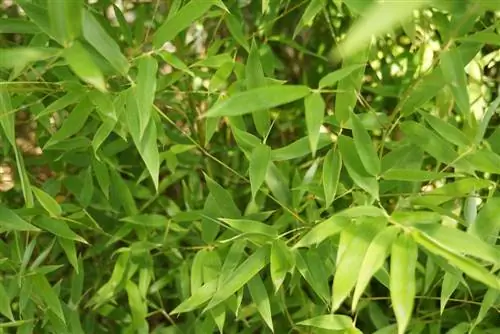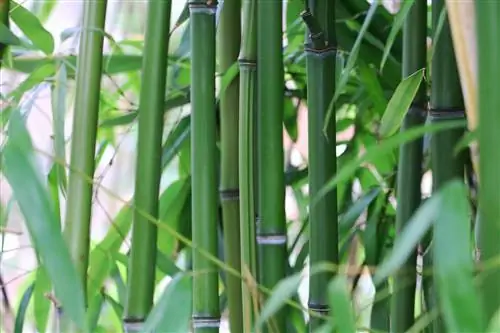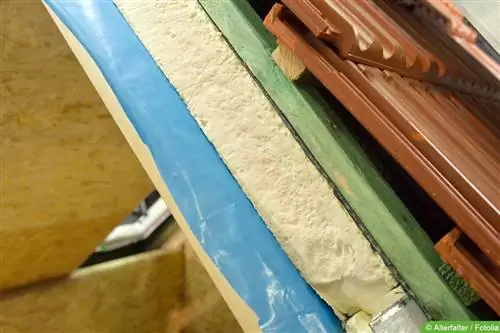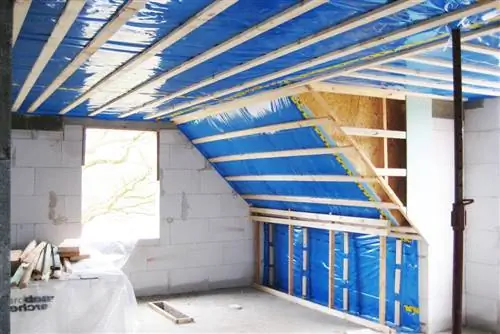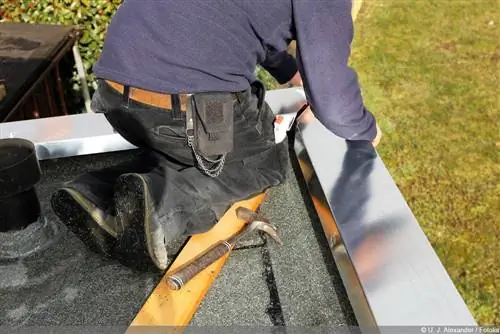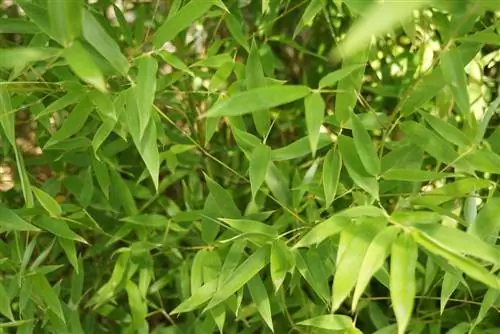- Author admin [email protected].
- Public 2023-12-17 03:39.
- Last modified 2025-01-24 12:45.
When planting a bamboo bush, protection against uncontrolled spread of the fast-growing roots should be planned. Especially if the bamboo is to find its new location near property boundaries, garden paths, ponds, streets and foundations. Such protection can also be installed later. However, it is important to choose the right material and the appropriate installation depth for the bamboo barrier. The root runners, so-called rhizomes, are very strong and pierce almost anything that comes their way.
Profile
- Bamboo barrier is also called rhizome barrier, root barrier or root barrier
- protects against uncontrolled spread
- only makes sense if the plant reproduces via root runners
- Materials: special film
- Thickness: at least 2 mm
- Depth: at least 70 cm, for some plants 100 cm
- mostly with locking rail for the ends
Why is a bamboo barrier necessary?
Bamboo is one of the plant species that reproduce deep in the soil via long, root-like runners (rhizomes). In older bamboo plants, these runners can grow up to a few meters long and then suddenly form shoots far away in neighboring beds, on the lawn or even on neighboring properties. These individual shoots quickly develop into whole plants, which in turn continue to multiply through rhizomes. Within a few years, a larger species of bamboo takes over entire areas and smothers everything that previously grew there.
Do all bamboo species need a barrier?
Not all bamboo species produce extensive root runners. The individual species are differentiated between:
- Floating foothills (bamboo barrier urgently needed)
- growing clumpy (without bamboo barrier)
Bamboo species that grow in clumps do not form runners, but reproduce via seeds. These only include a few varieties:
- Fargesia (garden bamboo)
- Borinda (new genus, breeding since 1994)
What to do if the bamboo lock is forgotten?
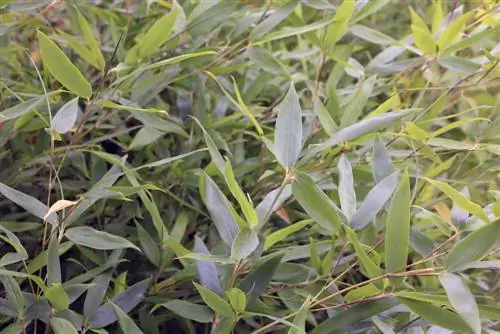
When purchasing a bamboo, a gardener is often not sufficiently informed of the extreme spreading behavior of the bamboo. For many years there was widespread ignorance in this area. The gardener only realizes that the plant is quite spreading when it is almost too late. But don't worry, you don't have to dig up and destroy the entire plant now, a bamboo barrier can also be installed later.
Subsequent installation
As a rule, the subsequent installation of a bamboo barrier is not a problem, it is just very labor-intensive. The solution is very simple: Dig a narrow trench around the bamboo and insert a rhizome barrier. The ditch is then filled in again. Depending on the nature of the soil and the amount of work involved, this can be done with different tools.
- hardened drainage spade and pickaxe
- Trencher
- Mini excavator
Tip:
For very large bamboo species or old stands, an installation depth of 70 centimeters is no longer sufficient. Here it makes sense not to save money at the wrong end and to set a barrier with a depth of 100 centimeters.
Materials for the film
Special films are available commercially for installation as a rhizome barrier. Simple pond liners, root barriers or root protection films are not suitable for this purpose as they are quickly broken through by the hard root runners. Variants made of polypropylene, as well as rubber mats, old rain barrels or thinner films cannot withstand the rhizomes. A 2 mm thick film made of high density polyethylene offers good protection. This bamboo barrier is also available from specialist retailers under the name PEHD or HDPE film. When purchasing, pay attention to:
- Root strength
- Frost resistance (at least -30 degrees)
- rodent festival
- chemical resistance
- Free from harmful substances
- UV stability
Tip:
Good films cost on average per running meter: 6 euros (70 cm width) or 9 euros (100 cm width). Added to this are around 20-30 euros for a connecting rail made of aluminum.
Space requirement
The vigor of rhizome-forming bamboo species should not be underestimated. Even under our climatic conditions, larger varieties reach an area of around 20 m² after around 5-10 years without a bamboo barrier. We recommend limited areas of at least 8-12 m² so that the plant can still develop well.
Calculation of space requirements
Growth height x 2.5=minimal space requirement
Example: Expected growth height of the fully grown plant: 10 m
This results in 10 x 2.5=25 m². A square area would therefore have an edge length of 5 x 5 m.
Install bamboo barrier
It's best to use a 100 centimeter wide film. And you need to dig an equally deep trench around the plant. The area that is still left for the bamboo to grow must not be calculated too tightly. Just as important as the right material and installation depth is that the film should never be flush with the top edge of the ground. It must be at least five centimeters above ground level. Otherwise, the rhizomes can grow over it and spread further.
- Dig a trench around the plant
- Depth: about 65 or 95 cm
- (note the space required by the bamboo)
- Let the film protrude 5 cm above ground level
- both ends of the film have a closure (safety rail)
- Fill in the ditch again
- Compact the soil well
If you cannot or do not want to provide your bamboo barrier with a screwed locking rail, you have the option of leaving the film open about 50 centimeters on one side. There is no earth filled in from the outside, but simply filled with dry leaves or straw. If rhizomes form, they are automatically guided to this free spot and can then be cut off with a spade once or three times a year.
Attention
The bamboo rhizomes don't stop at walls! Anyone who plants bamboo on the house wall must seal it in all directions (including towards the house wall) with a bamboo barrier.
Supply within a bamboo barrier

The gardener must never forget that a bamboo inside a rhizome barrier can no longer be compared with plants that grow outside in the wild. Water and nutrient content in the soil are now only available to a limited extent. Bamboo can now almost be compared to a potted plant. Therefore, the larger the defined area, the easier the plants are to care for and the harder they are in winter. Please also note:
- water regularly (even on frost-free days in winter)
- Think out the bamboo again and again (cut the shoots close to the ground)
- After a few years, dig up a complete piece of soil including roots and rhizomes and fill it with new soil (this is the only way the roots will have permanent space)
Conclusion
So that the roots of bamboo do not spread throughout the garden, a bamboo barrier must be installed for many species. If this was forgotten when planting, it can easily be used later. However, this involves a lot of work. To do this, a narrow trench about one meter deep must be dug around the plant and a special film made of high-density polyethylene must be inserted. After that, the bamboo is no longer a real outdoor plant, but rather should be treated like a potted plant.
Tips for assembling a rhizome barrier
It is best to use the rhizome barrier immediately when planting the bamboo. This means the plant can be put in its place right from the start. If it is a subsequent installation, you should first look at how far the roots of the bamboo have already spread. A trench is dug according to this spread or the area in which the bamboo is to grow.
Now you need a correspondingly long rhizome barrier, the beginning and end of which are connected to a ring using the aluminum rail mentioned above. The HDPE sheets should overlap a little in the rail and are then fixed with screws in the corresponding holes. This ensures that there is a seamless connection.
If this were not the case, the roots of the bamboo could grow into the rail and destroy it. It is crucial to know at this point that bamboo needs a lot of space. A rhizome barrier should have a diameter of at least 1.5 meters.
You can tell that the rhizome barrier was chosen too small because the bamboo gets yellow leaves over time and suddenly withers.
The rhizome barrier itself should be inserted around 64 centimeters deep into the soil. At the top edge it should protrude about five centimeters from the ground. Although this is not the best visual highlight, it is quite important to avoid further spreading. This overlap can be cleverly fixed with a few stones and covered at the same time.

